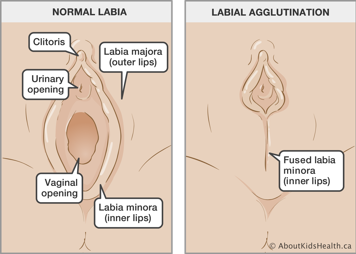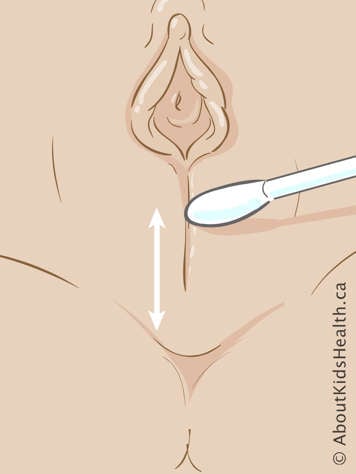What is labial agglutination?
The labia are thin folds of skin around a girl's vagina. When a young girl's labia are stuck together, this is called labial agglutination. Sometimes the skin covers part or all of the opening of the vagina. Sometimes the skin also covers part of the urethra, where urine comes out.
Labial agglutination is also called "labial adhesion" or "fused labia". However, the labia are not permanently stuck or fused together.
Labial agglutination is common and is usually painless. In fact, most parents and children do not notice the condition until a parent or health-care provider sees the genital area. In some cases, the condition is noticed because the skin is interfering with urination.

No one knows what causes labial agglutination
Labial agglutination happens most often in girls aged between three months and six years old. In girls this age, the skin around the vagina is very delicate. This skin does not contain the female hormone called estrogen. Estrogen helps to stop the labia from sticking together. When girls go through puberty and their bodies start making estrogen, labial agglutination usually goes away without treatment.
Diagnosing labial agglutination
If your child has labial agglutination, their health-care provider will want to make sure they can urinate without problems, and that there are no other problems with the vagina or the skin around it.
If your child is old enough, their health-care provider will explain to them what is going on, using words that are simple to understand. This will ensure that your child is not scared during the examination.
Mild cases
If the labial agglutination is small and your child can go to the bathroom without problems, your child may not need treatment. You may be asked to apply a barrier cream such as petroleum jelly (Vaseline) or zinc oxide on the labia. This will keep the rest of the labia from sticking further. As your child enters puberty and begins to produce more estrogen, the labia will probably stop sticking together on their own.
If the skin is sticking together more than before or if your child has trouble going to the bathroom, consult their health-care provider.
Treating labial agglutination with hormone creams or topical steroids

Sometimes children with labial agglutination are prescribed a hormone cream containing estrogen or a steroid cream. Put a pea-sized amount every day on the place where the labia are stuck together. Use a cotton swab or fingertip to gently apply the cream.
Whichever cream is prescribed, it may take several weeks to open the labia. Sometimes, the estrogen cream will make the skin around the vagina change colour. The skin colour will go back to normal after the treatment. If it is used for a long time, or in large amounts, it can make the breasts grow larger or cause some vaginal bleeding. These are temporary side-effects. Your child's breasts will go back to normal and the vaginal bleeding will stop once the treatment is stopped.
When used correctly, topical steroids rarely have side effects. If you have concerns about these medications, talk to your health-care provider about them.
Surgery for labial agglutination is very rare
Rarely, if the cream does not work, surgery may be needed.
Stopping labial agglutination from happening again
Labial agglutination can come back. To stop it from coming back, keep using barrier creams such as petroleum jelly and zinc oxide on the labia. This will keep them moist and stop them from sticking together.
If the problem does come back, use estrogen and barrier creams as before.
When your child enters puberty, labial agglutination will probably not happen again.
Applying the creams with care
Depending on their age, you may let your child help you put the cream on. If your child is too young for this, try distracting them with a toy while you are putting on the cream.
Other things parents can do to help
- Do not try to pull or force the labia open in any way. This will be painful and will distress your child. It can damage the skin and make your child fearful of being examined.
- Zinc oxide or petroleum jelly (Vaseline) cream can be applied two to three times a day to keep the skin moist.
- Have your child take a daily bath or use a sitz bath to make sure they are clean. The bath water should have no soap or suds. A sitz bath is a small tub that can be placed on the toilet and filled with warm water to soak the vulvar region. You can purchase a sitz bath at most pharmacies.
- Estrogen cream, petroleum jelly or zinc oxide should be put on after the bath.
- Do not use strong soaps, perfumes or bubble bath. These can irritate the skin around the vagina.